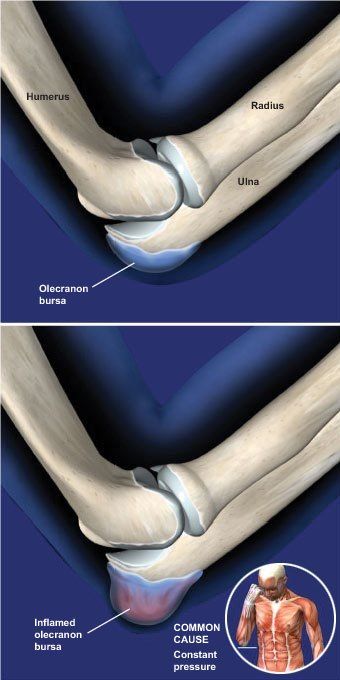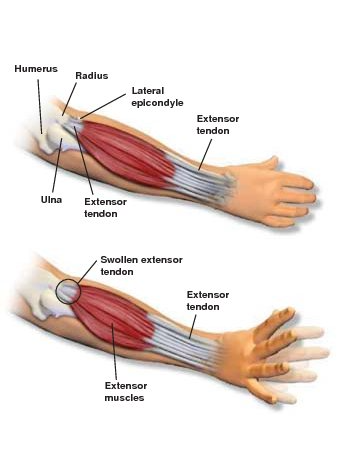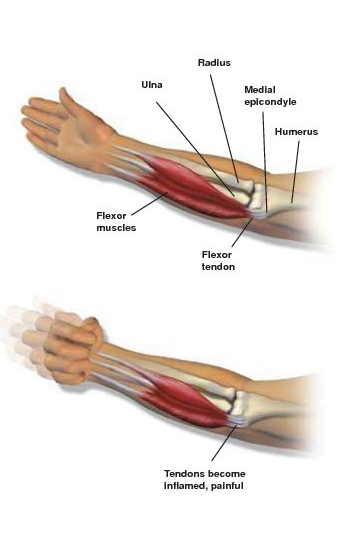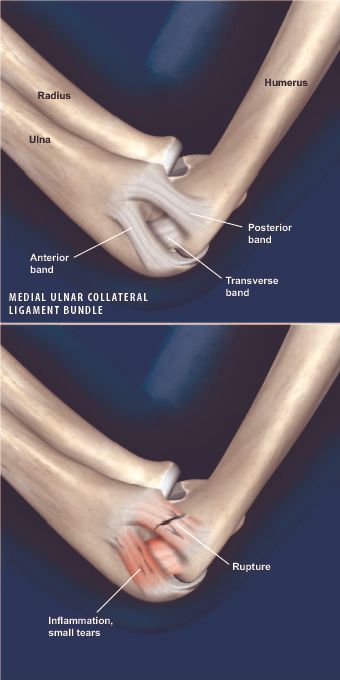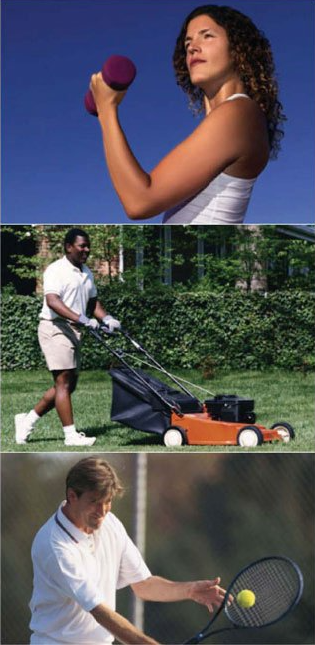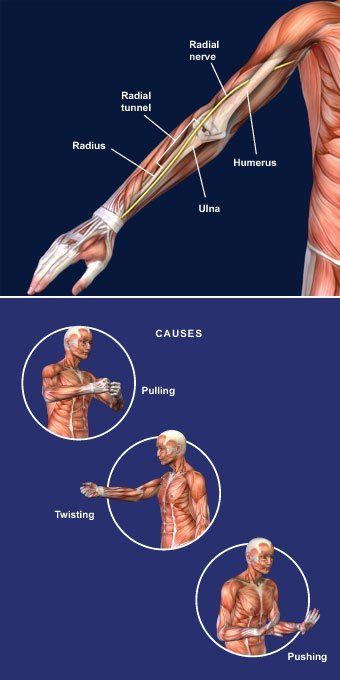ELBOW CONDITIONS
Cubital Tunnel Syndrome
Overview
This condition is a compression injury to the ulnar nerve near the elbow. This is the nerve that produces a jolt when you bump your "funny bone."
Anatomy
The ulnar nerve travels along the inside of the arm through the cubital tunnel - a closed pathway surrounded by tissue and bone - and then to the hand.
Causes
Cubital tunnel syndrome occurs commonly when the cubital tunnel is compressed by muscles, tendons or bone, or when the ulnar nerve frequently shifts or stretches abnormally. It is often caused by flexing the elbow for long periods of time. Constant pressure on the nerve (typically caused by leaning on the elbow for long periods) can also cause the syndrome, as well as injury to the elbow.
Symptoms
Cubital tunnel syndrome may cause numbness, weakness, or pain in the hand and pain on the inner side of the elbow. The hand may feel like it is "falling asleep," or pain can radiate from the elbow into the hand. This pain and numbness is typically limited to the ring and small fingers of the hand.
Treatment
Treatment options include rest, immobilization with a splint, cushioning of the nerve with an elbow pad, and anti-inflammatory medications. In severe cases of pain, numbness, or weakness, surgery may be needed to relieve pressure on the nerve.
© Swarm Interactive, Inc.
ELBOW BURSITIS
Overview
This is a swelling of a fluid-filled sac in the back of your elbow. This sac is called the "olecranon bursa." You have similar sacs near other large joints throughout your body. They act as cushions between your bones and your soft tissues. Normally they have a small amount of fluid inside them. But sometimes they can swell. That is called "bursitis."
Causes
Your olecranon bursa can swell if you injure your elbow by hitting it hard. It can swell if you put pressure on it, repeatedly, usually over months. That can happen if you have a job that requires you to crawl or to lean on your elbows a lot. The bursa can swell because of an infection in your elbow. And, swelling may be linked to conditions like arthritis or gout.
Symptoms
Symptoms may include swelling and pain. If you have an infected bursa, the skin of your elbow may feel red and warm. An infected bursa can cause serious illness.
Treatment
Treatment depends on your needs. The swelling may go down if you cushion your elbow with a pad and avoid leaning on your elbow. Medications may help, too. Your doctor may remove fluid from the bursa with a needle. If those options aren't helpful, or if you have an infected bursa, you may need surgery.
© Swarm Interactive, Inc.
LATERAL EPICONDYLITIS (TENNIS ELBOW)
Overview
This condition, commonly called tennis elbow, is an inflammation of the tendons that connect the muscles of the forearm to the elbow. The pain is primarily felt at the lateral epicondyle, the bony bump on the outer side of the elbow.
Inside The Elbow
The elbow joint is a complex group of bones, muscles, ligaments and tendons. Lateral epicondylitis involves the extensor muscles, which control the extension of the wrist and fingers, and the extensor tendons, which anchor the muscles to the lateral epicondyle.
Causes
Lateral epicondylitis is caused by specific repetitive motions of the wrist and arm. The stress placed on the forearm by a tennis backstroke is a common culprit. This stress causes tiny tears to develop in one or more extensor tendons. This results in inflammation and pain.
Symptoms
This condition typically causes pain and tenderness that is centered on the lateral epicondyle. This pain may radiate along the forearm and wrist. The grip of the hand may feel weak.
Risk Factors
Lateral epicondylitis typically affects people between the ages of 30 and 50. It is a common complaint of athletes who play racquet sports, but certain occupations can also raise a person's risk. This condition is common among plumbers, painters, carpenters and butchers.
Treatment
Treatment options may include rest, ice, anti-inflammatory medications and stretching exercises. We may recommend an arm brace or wrist splint and physical therapy or massage therapy. Steroid injections or PRP injections may also provide relief.
© Swarm Interactive, Inc.
MEDIAL EPICONDYLITIS (GOLFER'S ELBOW)
Overview
This condition, commonly called golfer's elbow, is an inflammation of the tendons that connect the muscles of the forearm to the elbow. The pain is primarily felt at the medial epicondyle, the bony bump on the inner side of the elbow.
Inside The Elbow
The elbow joint is a complex group of bones, muscles, ligaments and tendons. Medial epicondylitis involves the flexor muscles, which control the flexion of the wrist and fingers, and the flexor tendons, which anchor the muscles to the medial epicondyle.
Causes
Medial epicondylitis is caused by specific repetitive motions of the wrist and arm. The stress placed on the forearm by swinging a golf club is a common culprit. This stress causes tiny tears to develop in one or more flexor tendons. This results in inflammation and pain.
Symptoms
This condition typically causes pain and tenderness that is centered on the medial epicondyle. This pain may radiate along the forearm and wrist. The elbow may feel stiff, and the hand and wrist may feel weak. A person may experience numbness or tingling in the ring finger and little finger.
Risk Factors
Medial epicondylitis typically affects people older than 35. It is a common complaint of athletes who play golf and racquet sports. It also commonly affects people who play throwing sports, such as baseball and football, and people who participate in weight training. Certain occupations can also raise a person's risk. This condition is common among painters, carpenters and people who use computers.
Treatment
Treatment options may include rest, ice, anti-inflammatory medications and stretching exercises. We may recommend an arm brace or wrist splint and physical therapy or massage therapy. Steroid injections or PRP injections may also provide relief.
© Swarm Interactive, Inc.
MEDIAL ULNAR COLLATERAL LIGAMENT INJURY
Overview
This condition is an injury to the medial ulnar collateral ligament, a ligament composed of three bands located on the inner side of the elbow. The MUCL connects the humerus to the ulna. Injury to the MUCL can cause pain, weakness and sometimes a feeling of instability in the arm.
Causes
The medial ulnar collateral ligament is often injured by strenuous physical activity or sports that require repetitive motions, such as throwing a baseball or football. These motions can put stress on the ligament, causing inflammation, tears or, in serious cases, ruptures.
Symptoms
Symptoms of an injury to the medial ulnar collateral ligament can include sharp pain along the inside of the elbow joint, swelling, and weakness in the arm. Some patients may hear or feel a pop when moving the elbow.
Treatment
Treatment options can include rest, anti-inflammatory medications, a cold compress, or the use of a brace to stabilize the elbow. Severe tears or ruptures may require surgery.
© Swarm Interactive, Inc.
OSTEOCHONDRITIS DISSECANS OF THE ELBOW
Overview
This is a disorder that most often affects young athletes. It happens when part of a bone in the elbow loses its blood supply. It weakens, and so does the cartilage that covers it. Bone and cartilage may break off and drift around in the elbow. That can cause the joint to catch and lock up.
Causes
What causes bone to lose its blood supply? The exact cause isn't fully understood. It can happen if you repeatedly stress your elbow. Sports that involve throwing motions, such as baseball and tennis, can increase your risk. This disorder may also be linked to genetic factors.
Symptoms
Symptoms may include pain, stiffness and a popping sensation in the elbow. The joint may be swollen and tender. It may be hard to fully straighten your arm. Your elbow may feel like it catches or locks, and it may not feel stable.
Treatment
Treatment options depend on your needs. If the weakened piece is still in place, it may heal on its own with proper rest. You may benefit from an elbow brace, medications and physical therapy. If these options aren't helpful, or if the piece has broken away and moved around in the joint, it can be repaired with surgery. Your healthcare provider can create a plan that's right for you.
© Swarm Interactive, Inc.
OVERUSE INJURIES OF THE ELBOW
Overview
If you are an athlete, or if you work with your arms and hands, your elbows may be at risk for an overuse injury. This is an injury caused by repetitive motions. This type of injury can be a problem for people who play sports such as tennis or baseball. Children also have a higher risk, because their bones are still growing.
Causes
The elbow is a complex joint where three bones meet. When you do the same arm motion again and again, you can put a lot of stress on this joint. You can fracture a bone, or you can damage the cartilage that protects the ends of your bones. You can stretch or tear the ligaments that stabilize the joint. You can injure the tendons that anchor your muscles to the bones. These injuries can compress or irritate the nerves in your elbow. And these injuries can be slow to heal.
Symptoms
If you have an overuse injury, you may have pain and swelling. You may hear sounds such as clicking or popping when you move your elbow. You may feel weakness, numbness or tingling. These symptoms can affect your arm and your hand.
Treatment
Treatment options depend on your specific injury. Often, elbow injuries can be treated with rest, ice, medication and physical therapy. You may benefit from a brace or a cast. Your healthcare provider can create a plan that is right for you.
© Swarm Interactive, Inc.
RADIAL TUNNEL SYNDROME (ENTRAPMENT OF THE RADIAL NERVE)
Overview
This condition is thought to be a compression injury to the radial nerve near the elbow. This condition is often confused with tennis elbow.
Anatomy
The radial nerve travels through the radial tunnel, an open space surrounded by muscle and bone, along the outer side of the elbow and then to the hand.
Causes
Radial tunnel syndrome occurs when muscles of the forearm compress the radial tunnel, pinching the radial nerve at one or more points. This is typically caused by repetitive motions such as pushing or pulling, twisting, gripping with the hand or bending the wrist. It can also be caused by injury to the elbow.
Symptoms
Radial tunnel syndrome causes pain along the outer side of the arm about two inches below the elbow. The pain worsens when the arm is used. Weakness of the wrist and hand can also occur.
Treatment
Treatment options include rest, immobilization with a splint, and anti-inflammatory medications. In severe cases or when symptoms are not relieved, surgery may be necessary to relieve pressure on the nerve.
© Swarm Interactive, Inc.


